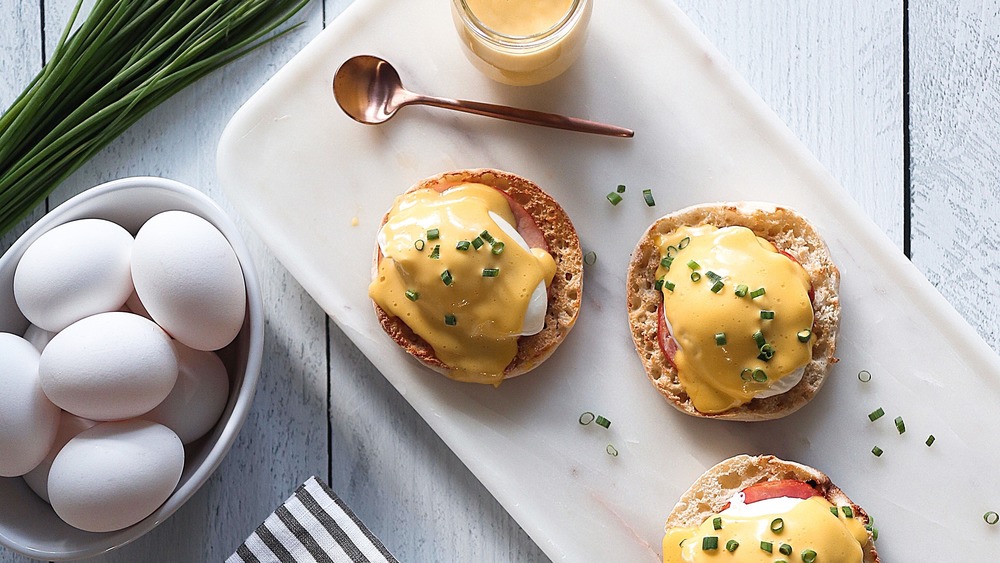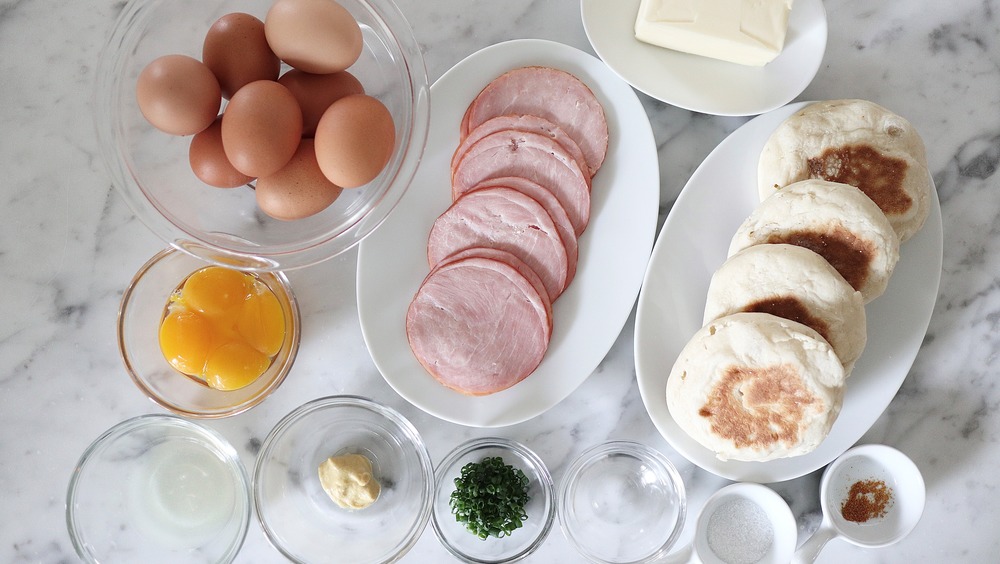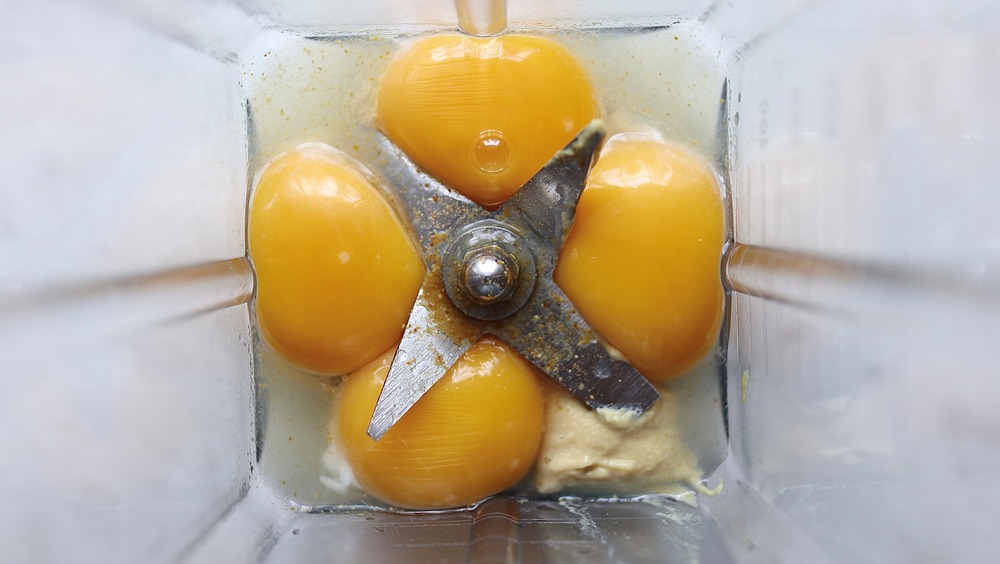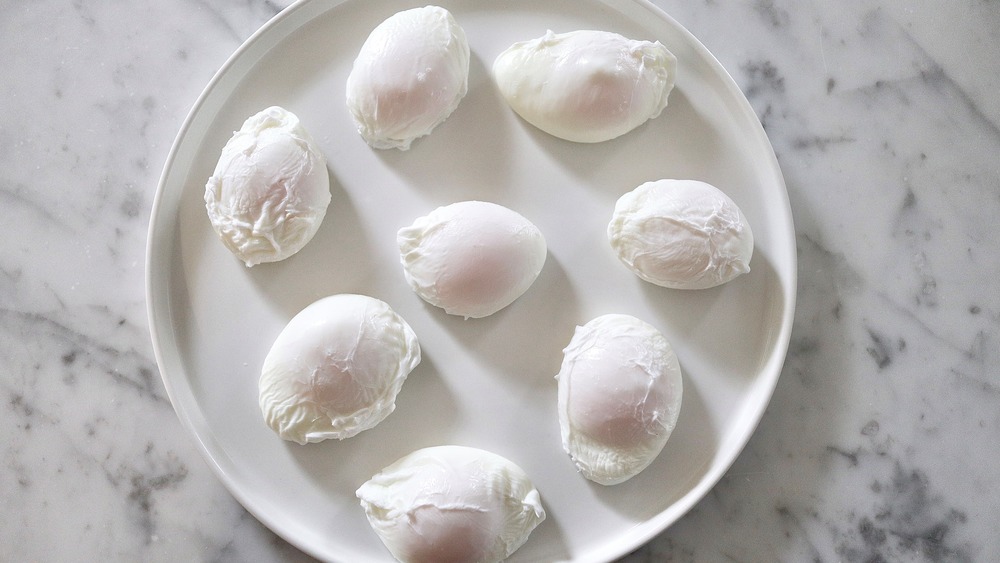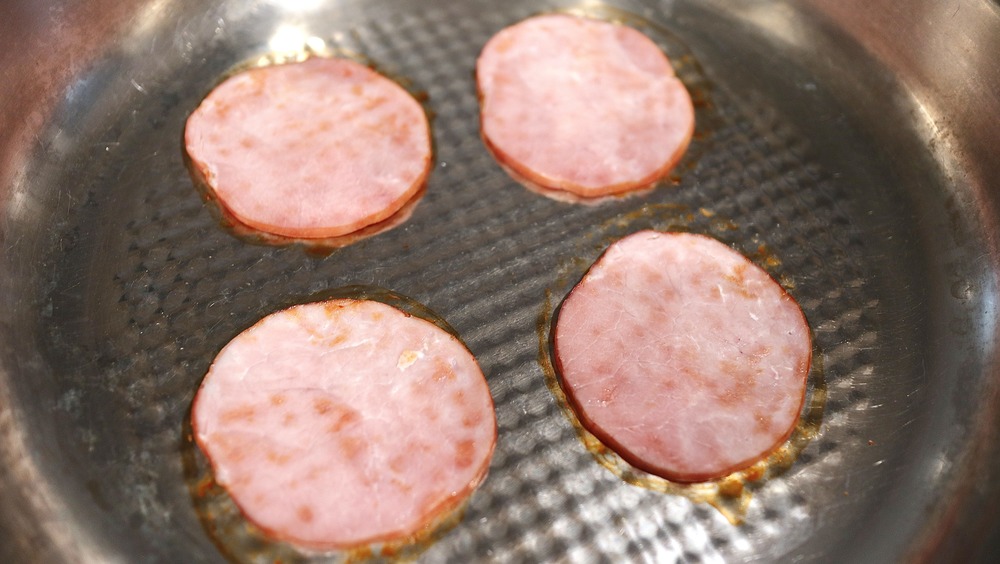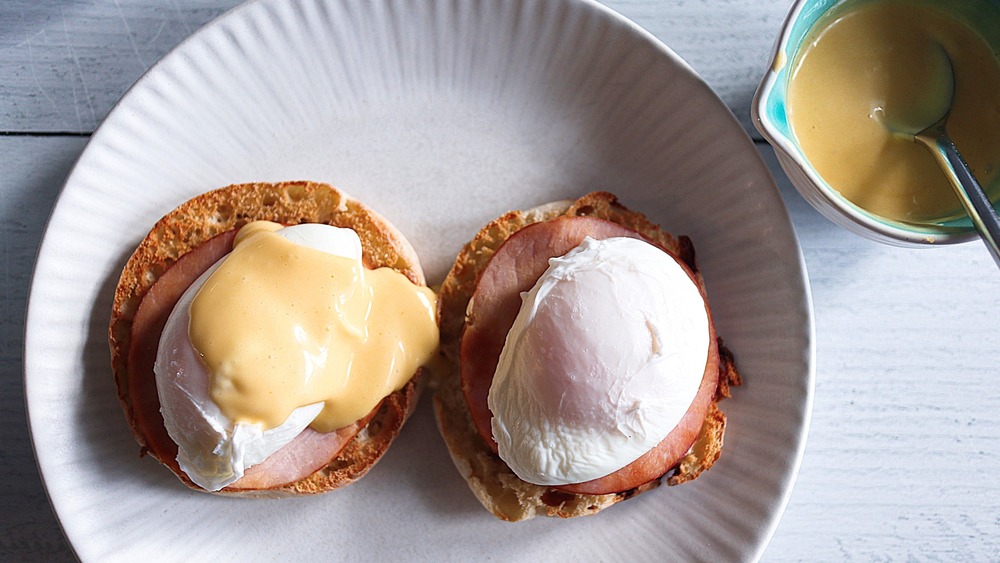Eggs Benedict Recipe
If you've always been a bit intimidated by making eggs Benedict, frankly you're not wrong to feel that way. This superlative breakfast classic is not an easy meal to make, at least not the first few times you prepare it. That's true for two primary reasons. One, to make great eggs Benedict, you need perfectly poached eggs, which is no easy feat at all. Second, eggs Benedict is made complete by the Hollandaise sauce you ladle atop the poached eggs. Said sauce itself can be tricky to prepare even for the most experienced cooks.
Fortunately, chef and food writer Cecilia Ryu has some tips and tricks that will take your egg poaching from stress and mess to reliably successful and rather less stressful. She's also produced a Hollandaise sauce recipe that's a surefire win as long as you follow it closely.
Want a pro-tip preview on creating good Hollandaise sauce, even though it's one of the intimidatingly-named "mother sauces"? "Make sure the melted butter is hot when drizzling into the blender," says Ryu. Want another pro-tip on how to get really good at making eggs Benedict, while eating well in the process? Go ahead and make this meal for yourself a few times before you serve it at a brunch party. The truth is that poached eggs can take a while to master, even with Ryu's clever mesh sieve trick.
Gather your ingredients for eggs Benedict
A full-on ideal meal of eggs Benedict is a filling affair indeed. To serve four people a breakfast they'll long remember, start with the sauce. For the Hollandaise sauce, you'll need a half cup of unsalted butter, four large egg yolks, one tablespoon of lemon juice, a teaspoon of Dijon mustard, a quarter teaspoon of salt, and a pinch of cayenne pepper for the sauce. For the main event, you'll need eight large eggs, a tablespoon of white vinegar, four English muffins, eight slices of Canadian bacon, and chopped chives for topping.
No Canadian bacon? Regular bacon or sliced ham will do nicely, though these types of bacon are clearly distinct from one another. And no English muffins or even crumpets? Well, then off to the store with you, or better yet make some fresh yourself.
Prepare the Hollandaise sauce for eggs Benedict
You can prepare your Hollandaise sauce first, provided you can keep it warm while poaching your eggs, cooking your bacon, and toasting your muffins. It's best to have everything else at least prepped and ready, as the fresher this meal is served, the better.
To make the sauce, first melt butter in a small saucepan over medium-low heat. Make sure it stays hot and melted, as "if the butter cools down and hardens, it will not emulsify into a smooth sauce," Ryu cautions. Now combine the four egg yolks, lemon juice, Dijon mustard, salt, and cayenne pepper in a blender. Blend on medium to combine, which will take approximately 10 seconds. Turn the blender speed to medium-low and slowly drizzle in the hot melted butter until it is fully incorporated and emulsified.
Taste to adjust seasoning if necessary, noting that Hollandaise sauce should be creamy and rich with just a touch of acidity. When ready, pour the sauce into a bowl, cover it, and place it in a warm spot until it's ready to use. Alternately, you can pour the Hollandaise sauce in a thermos to keep it warm.
Prepare perfect poached eggs
Fill a broad, medium-depth saucepan halfway with water and bring it to a gentle simmer. While you wait on the water, crack one egg into a small, fine-mesh sieve over a bowl. This will allow the thin, watery whites to separate from the firmer whites that are attached to the yolk. Once the watery whites have drained into the bowl, which typically takes about 30 seconds, transfer the rest of the egg to a small bowl or ramekin. Repeat the process with the remaining eggs.
Once the water is simmering, add the vinegar and then stir the water to create a gentle vortex. No, you don't need to add salt. Carefully drop your first egg into the center of the vortex and keep stirring. This will help your egg to stay whole, rather than developing unattractive strings of trailing egg whites as they cook.
Once the whites have begun to set, add another strained egg. Repeat the process until you have three or four eggs in the saucepan. Cook your eggs until the whites are firm and cooked through, but the yolks remain soft and runny, which will take approximately three minutes for each egg.
Using a slotted spoon, gently remove the eggs from the water and transfer them to a plate. Set aside, ideally somewhere you can keep them moderately warm. As you continue poaching, you may see egg white foam accumulate on the surface of the water. Use a fine-mesh sieve to remove it.
Toast your English muffins and cook your Canadian bacon
Preparing the English muffins and Canadian bacon is probably the easiest part of this process. In fact, your hard work is now over, so enjoy the smooth sailing from here on. First, take care of the carbs. In a toaster or a good old oven, simply toast the English muffins for a few minutes, until they are golden brown.
While English muffins are toasting, heat a skillet over medium-high heat using a dash of oil or a bit of butter to coat it. Add the Canadian bacon and cook until it's heated through and browned, which requires approximately one minute on each side. And if you haven't done so yet, go ahead and chop the chives.
Assemble the eggs Benedict
Assembling a perfect plate of eggs Benedict is actually quite easy once you have the ingredients prepped. Plus, this meal makes for a gorgeous presentation. You'll need four plates ready for serving given the ingredients used here.
Place two English muffin halves on each plate and top each with a slice of Canadian bacon. Carefully place a poached egg on top of the bacon, then spoon Hollandaise sauce over each egg. Garnish with chopped chives and, if you'd like, a pinch of black pepper. Briefly admire your handiwork, then serve good and warm.
The Best Eggs Benedict Recipe You've Ever Tried
It easy to be intimidated by eggs Benedict. Fortunately, chef and food writer Cecilia Ryu has some tips that will take this classic dish from stress to success.
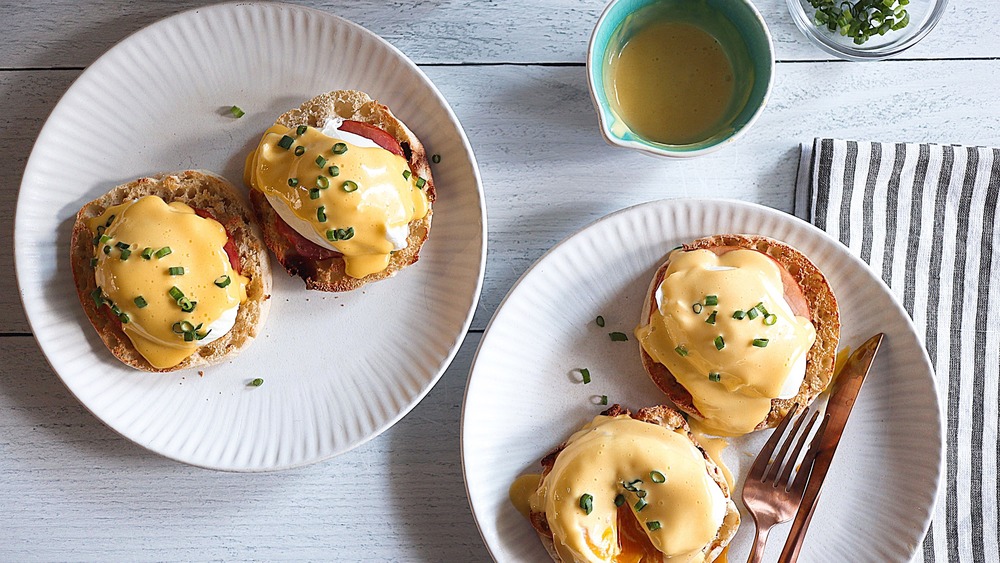
Ingredients
- ½ cup (1 stick) unsalted butter
- 4 large egg yolks
- 1 tablespoon lemon juice
- 1 teaspoon Dijon mustard
- ¼ teaspoon salt
- Pinch of cayenne pepper
- 8 large eggs
- 1 tablespoon white vinegar
- 4 English muffins, split in half
- 8 Canadian bacon slices
- 1 tablespoon chopped chives
Directions
- To prepare Hollandaise sauce, melt butter in a small saucepan over medium/low heat. Then combine four egg yolks, lemon juice, Dijon mustard, salt, and cayenne pepper in a blender. Blend on medium to combine, approximately 10 seconds. Turn the blender speed to medium-low and slowly drizzle in the hot melted butter until it is incorporated and emulsified.
- Taste to adjust seasoning if necessary. The Hollandaise sauce should be creamy and rich with a touch of acidity. Pour sauce into a bowl. Cover and place in a warm spot until ready to use. Alternately, place Hollandaise sauce in a thermos to keep warm
- To poach the eggs, fill a medium saucepan halfway with water and bring to a gentle simmer. While water is coming to a simmer, crack one egg into a small fine-mesh sieve over a bowl. This will allow the thin, watery whites to separate from the firmer whites that are attached to the yolk. Once the watery whites have drained into the bowl, about 30 seconds, transfer the egg to a small bowl or ramekin. Repeat this process with remaining eggs. Discard watery whites accumulated in the bowl or save them for future use.
- Once the water comes to a gentle simmer, add the vinegar. With a spoon, stir the water to create a gentle vortex. Carefully drop an egg into the center of the vortex and continue to stir the water gently.
- Once the whites have started to set, add another strained egg. Repeat until you have 3-4 eggs in the saucepan at a time. Cook until whites are firm and cooked through, but the yolks are very soft and runny, approximately 3 minutes for each egg
- Using a slotted spoon, gently remove eggs from water and transfer to a plate. Set aside. You may have egg white foam accumulate on the surface of the water. Use a fine-mesh sieve to remove as needed.
- Prepare English muffins in a toaster or oven and cook until golden brown
- While English muffins are toasting, heat a skillet over medium-high heat. Add Canadian bacon and cook until heated through and browned, approximately 1 minute on each side.
- Assemble the eggs Benedict on four plates, with two each of muffins, ham slices, and eggs per plate. Place two English muffin halves on each plate and top each with a slice of Canadian bacon. Carefully place a poached egg on top of each slice. Spoon Hollandaise sauce over each egg and garnish with chopped chives.
Nutrition
| Calories per Serving | 594 |
| Total Fat | 39.8 g |
| Saturated Fat | 20.0 g |
| Trans Fat | 1.0 g |
| Cholesterol | 644.8 mg |
| Total Carbohydrates | 28.0 g |
| Dietary Fiber | 2.7 g |
| Total Sugars | 2.0 g |
| Sodium | 791.9 mg |
| Protein | 32.1 g |
